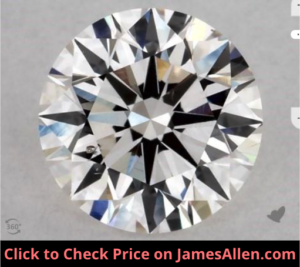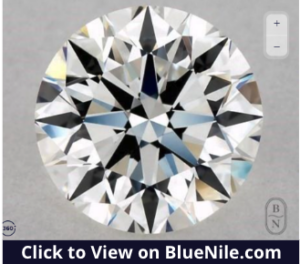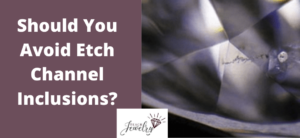
A diamond’s inclusions have the potential to impact its appearance and brilliance, but not all flaws affect it the same way.
One example of an inclusion you’ll often see on a diamond grading report is an etch channel.
In this article, you’ll learn everything about etch channel inclusions, including how to find them on a report, how they influence price, if they can be fixed, and whether you should consider it a dealbreaker.
What is an Etch Channel?
Etch channel inclusions are thin, hollow tunnels that begin on the diamond’s surface and penetrate inside.
They’re naturally-occurring and formed when a diamond is pushed from Earth’s crust to the surface. Intense heat causes gas trapped inside to escape and form the narrow hole, or the high temperatures break through the diamond’s structure.
The inclusions are not always straight lines. Instead, they can appear as jagged lines that adjust their path based on interactions with other inclusions. In most cases, the etch channel will stop when it hits another solid inclusion.
To illustrate, here’s an image from the Gemological Institute of America (GIA) of a diamond where the etch channels are highlighted.
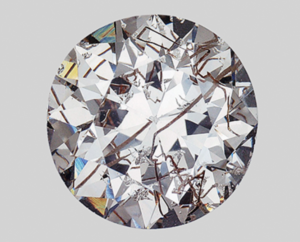
Notice how some are long, and others are short. They span across the table, crown, and pavilion.
How do Etch Channels Impact a Diamond’s Quality?
Appearance
In the case of etch channels, large instances that penetrate deep inside a diamond can be seen by the naked eye. You may notice the hole on its surface or the wriggly line within it.
The best way to know if an etch channel affects appearance is to check the clarity grade. If it’s SI1 or above, there’s a chance it’s eye-clean, meaning the imperfections are only visible with magnification.
It should be noted etch channels have the potential to fill with dirt and grime, which increase its visibility. This is most prevalent when the flaw is on the pavilion side.
The risk increases if the hole at the surface is large because there’s more room for the debris to enter the diamond.
Once it’s inside, it can be difficult to remove or could require a professional cleaning.
Durability
Durability is also an important factor in selecting a diamond. Small etch channels are generally not a cause for concern. The best way to know for certain is the clarity grade.
Durability is taken into account when determining the presence of inclusions, so a high clarity grade of VS2 or above shouldn’t cause problems, even if those inclusions are etch channels.
Avoid this clarity characteristic in locations where the diamond is already vulnerable.
For example, the corners of princess cuts are sharp and more susceptible to chipping.
A large inclusion such as an etch channel in that position is more likely to cause durability concerns than one near the edge of a round cut.
To illustrate, here’s a round-cut diamond with an etch channel near its table.
It’s size and location indicate it wouldn’t cause issues with durability, but it’s visible in the high-resolution image.
Brilliance
Inclusions also impact a diamond’s light performance and brilliance because they prevent light from properly entering and exiting the stone.
Etch channels are a type of inclusion that have less of an influence on brilliance compared to others. You shouldn’t eliminate a diamond containing an etch channel on the basis of it diminishing brilliance.
The quality of the diamond’s cut is a far more important factor.
Etch Channels on Grading Reports
Organizations such as the GIA and American Gem Society provide grading reports on diamonds so buyers know its quality across categories such as color, cut, carat, and clarity.
One feature of their grading reports is a clarity characteristics plot, which shows the types of inclusions in a diamond, their size, and location.
This plot is where you can learn if a diamond has etch channels and if they’re significant enough to affect the diamond’s overall appeal.
For example, here’s the GIA report for a one-carat diamond that has a couple etch channels, labeled by a green box inside a red box.
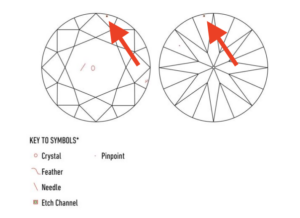
The etch channels are so small they’re barely visible on the report. The high-quality photo demonstrates they aren’t visible to the naked eye.
The grading report assures the buyer etch channels wouldn’t cause a problem with the diamond’s appearance, durability, or brilliance.
How do Etch Channels Affect a Diamond’s Price?
Inclusions negatively affect a diamond’s overall quality, so their presence lowers its price.
Diamonds that are flawless or internally flawless receive the highest clarity grades and sell at a premium, but all others are priced according to the impact of its inclusions.
The best way to know how etch channels affect a diamond’s price is to compare the price of flawless diamonds to ones with etch channel inclusions, where other qualities about the diamond are equal.
To start, this 0.90-carat diamond earned a flawless grade, in addition to an H color and very good cut. Its price is $6,210.
As a comparison, this diamond has all the same grades, except its clarity is SI2.
It costs $1,880. This shows the presence of etch channels, in addition to other inclusions, cuts the price by more than 50 percent.
If you were to find a diamond that contained fewer etch channels or less inclusions overall, with a grade such as VS2 or VS1, the price would land in the middle.
You could expect to pay between $4,000-$5,000 for a diamond of that quality.
Can Etch Channels be Removed?
Diamond cutters often choose not to remove etch channels because it would require re-polishing the stone and reducing its weight.
A higher carat weight allows a diamond to sell for a higher price. So the manufacturer has to make a cost-benefit analysis on whether it’s worth removing the etch channel and losing carat weight.
Because most etch channels are small and have minimal impact on the diamond’s overall quality, they often aren’t worth fixing.
For both the buyer and seller, it’s generally better to have a diamond with a higher carat weight and imperceptible etch channels versus no etch channels and a lower weight.
If the cutter believes the presence of large etch channels would diminish its value too much, the stone can be repolished to remove them or minimize their appearance.
In this case, you’d end up with a smaller diamond but with minimal impact from etch channels.
How do They Compare to Other Inclusions?
Most diamonds won’t have only etch channel inclusions. The clarity plot will show other types such as pinpoints, clouds, feathers, or twinning wisps.
In fact, those inclusions are far more common than etch channels.
On almost every diamond graded VS2 or below on the GIA clarity scale, you’ll see some combination of those inclusions.
Etch channels don’t affect the quality of a diamond as significantly as other inclusions. There are some inclusions you should avoid, especially if there are several or they’re large.
For example, feathers have the potential to impact a diamond’s durability. If a diamond is dropped or experiences a hard impact near its feather, it may chip.
Dark crystals can also be present. While etch channels often appear white or transparent, dark crystals are more easily visible to the naked eye.
I’ve posted a close-up image of a diamond with dark crystals below.
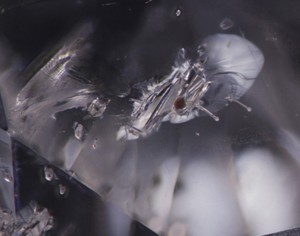
Etch channels are often confused with another type of inclusion: laser drilled holes. These holes are formed during clarity enhancement procedures to either remove or diminish the appearance of a dark inclusion.
They’re a sign the diamond has been clarity enhanced, which improves its appearance but lessens its value.
Laser drilled holes are man-made. Etch channels occur naturally.
Are Etch Channels a Dealbreaker?
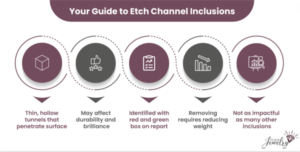
You shouldn’t remove a diamond from consideration solely because of etch channels. This type of inclusions isn’t an automatic dealbreaker.
I recommend purchasing an eye-clean diamond, which in most cases means it has at least an SI1 clarity grade.
It’s possible ones with high clarity grades like VVS1 to VS1 have etch channels, but as long as they’re small and can’t be seen with the naked eye, it can still be a quality diamond.
Keep it clean by preventing debris from entering the diamond through etch channels.
By looking for one within your price range and ensuring any etch channels don’t have a noticeable impact, you can select the right diamond for you.

Jacob Clarke
Jacob Clarke is the founder of TeachJewelry.com.
He earned an Applied Jewelry Professional Diploma from the Gemological Institute of America (GIA) and now brings you essential information about diamonds, settings, and more.
Jacob has consulted with leading jewelry brands, and his work has been cited in Clean Origin, Diamond Nexus and industry publications.
He's also a member of the International Gem Society.
He enjoys discussing jewelry with readers, so contact him with any questions at jacob.clarke@teachjewelry.com.

